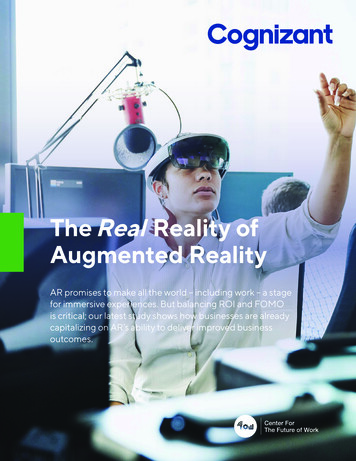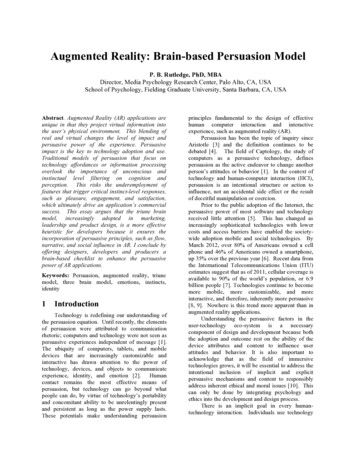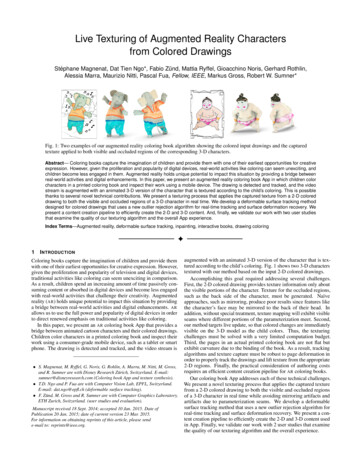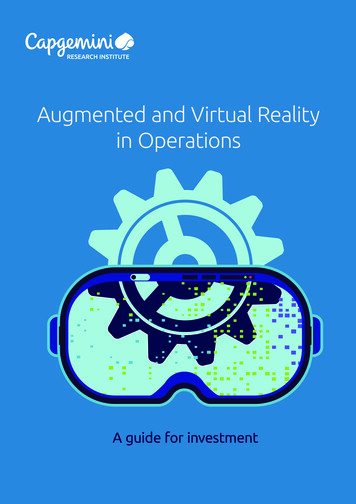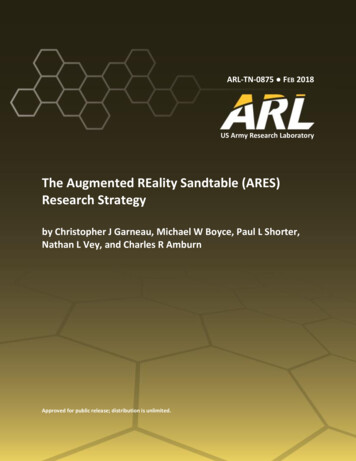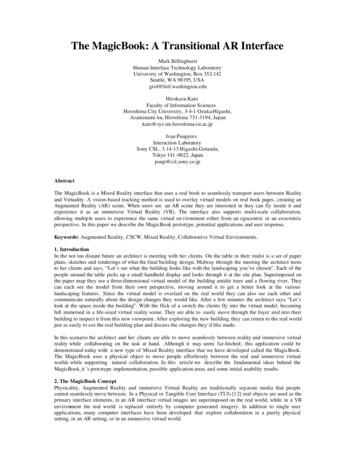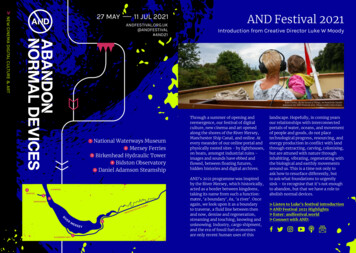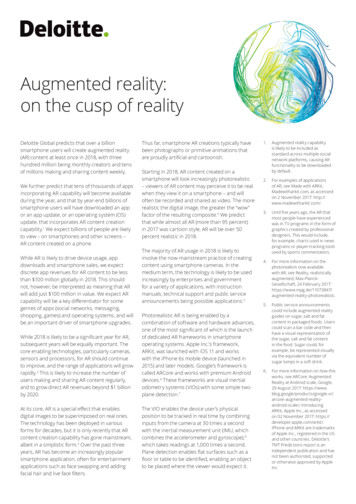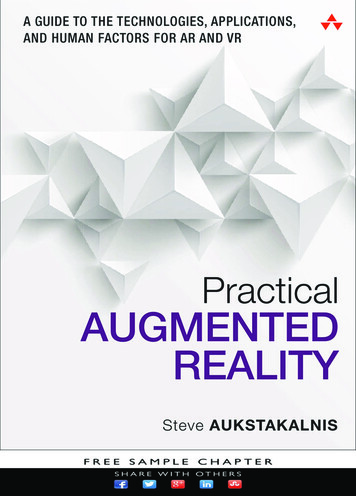
Transcription
Praise for Practical Augmented Reality“A valuable addition to the library of anyone setting out on their virtual journey.”—Dr Rab ScottHead of VR, Nuclear AMRC“A well-presented introduction to advanced visualization technologies, which will providereaders with an informed overview of this fast-paced, high-tech industry.”—Chris FreemanAugmented Reality Technical Fellow, University of Sheffield AMRC“Filled with excellent, imaginative information that will inform both experienced andfirst-time readers alike. Practical Augmented Reality is worth reading not only for its wealth ofdata and research, but also for its insights into the markets and opportunities ahead of us. If youhave an interest in this exciting new technology, this is a must-have resource and an enjoyableexploration into this brave new world.”—Roy TaylorCorporate Vice President for Content and Technology, AMD (Advanced Micro Devices)“Steven Aukstakalnis stands on the ever-changing edge of the virtual and augmented realityworld. Drawing from a rich history in the industry, he is able to share a clear understandingof the technologies, products, and ideas that will reshape the way we work and play. Maythe knowledge he shares empower you to help create a truly fantastic new future!”—Brent BaierCreator of the Peregrine Glove“Mixed or augmented reality is a grand frontier not only for computation, but for howpeople experience their world and each other. This book sets a frame around that which isn’tframed. Read it in order to understand our new world.”—Jaron LanierAuthor of Who Owns the Future and You Are Not A Gadget
This page intentionally left blank
PracticalAugmented Reality
This page intentionally left blank
PracticalAugmented RealityA Guide to the Technologies, Applications,and Human Factors for AR and VRSteve AukstakalnisBoston Columbus Indianapolis New York San FranciscoAmsterdam Cape Town Dubai London Madrid MilanMunich Paris Montreal Toronto Delhi Mexico CitySão Paulo Sydney Hong Kong Seoul Singapore Taipei Tokyo
Many of the designations used by manufacturers and sellers to distinguish their productsare claimed as trademarks. Where those designations appear in this book, and thepublisher was aware of a trademark claim, the designations have been printed with initialcapital letters or in all capitals.See the “Trademark and Copyright Information” section in Appendix B for a list of producttrademarks.The appearance of U.S. government visual imagery does not imply or constituteendorsement.The author and publisher have taken care in the preparation of this book, but make noexpressed or implied warranty of any kind and assume no responsibility for errors oromissions. No liability is assumed for incidental or consequential damages in connectionwith or arising out of the use of the information or programs contained herein.For information about buying this title in bulk quantities, or for special sales opportunities(which may include electronic versions; custom cover designs; and content particular toyour business, training goals, marketing focus, or branding interests), please contact ourcorporate sales department at corpsales@pearsoned.com or (800) 382-3419.For government sales inquiries, please contact governmentsales@pearsoned.com.For questions about sales outside the U.S., please contact intlcs@pearson.com.Visit us on the Web: informit.com/awLibrary of Congress Control Number: 2016946688Copyright 2017 Pearson Education, Inc.All rights reserved. Printed in the United States of America. This publication is protectedby copyright, and permission must be obtained from the publisher prior to any prohibitedreproduction, storage in a retrieval system, or transmission in any form or by any means,electronic, mechanical, photocopying, recording, or likewise. For information regardingpermissions, request forms and the appropriate contacts within the Pearson EducationGlobal Rights & Permissions Department, please visit www.pearsoned.com/permissions/.ISBN-13: 978-0-13-409423-6ISBN-10: 0-13-409423-9Text printed in the United States on recycled paper at RR Donnelley in Crawfordsville,IndianaPublisherMark L. TaubExecutive EditorLaura LewinDevelopment EditorSonglin QiuMarketing ManagerStephane NakibManaging EditorSandra SchroederSenior Project EditorLori LyonsProduction ManagerDhayanidhiCopy EditorGill Editorial ServicesIndexerTim WrightProofreaderH. MuthukumaranTechnical ReviewersYuval BogerVictor LuoEric MaslowskiCarl WakemanEditorial AssistantOlivia BasegioCover DesignerChuti PrasertsithFirst printing: September 2016CompositorcodeMantra
In memory of my mother and elder brother,both of whom passed away in the course of writing this book.You left us way too early and are deeply missed.
This page intentionally left blank
ContentsForeword . . . . . . . . . . . . . . . . . . . . . . . . . . . . xivPreface . . . . . . . . . . . . . . . . . . . . . . . . . . . . . . xviPart I: Introduction to Augmented and Virtual Reality1 Computer-Generated Worlds . . . . . . . . . . . . . . . . . .1What Is Augmented Reality? . . . . . . . . . . . . . . . . . . . . . . . . 2What Is Virtual Reality? . . . . . . . . . . . . . . . . . . . . . . . . . . . 8Conclusion . . . . . . . . . . . . . . . . . . . . . . . . . . . . . . . . . . 112Understanding Virtual Space . . . . . . . . . . . . . . . . . 13Defining Visual Space and Content . . . . . . . . . . . . . . . . . . 14Defining Position and Orientation in Three Dimensions . . . . . 16Navigation . . . . . . . . . . . . . . . . . . . . . . . . . . . . . . . . . . 22Conclusion . . . . . . . . . . . . . . . . . . . . . . . . . . . . . . . . . . 24Part II: Understanding the Human Senses andTheir Relationship to Output / Input Devices3The Mechanics of Sight. . . . . . . . . . . . . . . . . . . . . 25The Visual Pathway. . . . . . . . . . . . . . . . . . . . . . . . . . . . . 26Spatial Vision and Depth Cues. . . . . . . . . . . . . . . . . . . . . . 36Conclusion . . . . . . . . . . . . . . . . . . . . . . . . . . . . . . . . . . 534Component Technologies of Head-MountedDisplays . . . . . . . . . . . . . . . . . . . . . . . . . . . . . . 55Display Fundamentals . . . . . . . . . . . . . . . . . . . . . . . . . . . 56Related Terminology and Concepts . . . . . . . . . . . . . . . . . . 66Optical Architectures . . . . . . . . . . . . . . . . . . . . . . . . . . . 69Conclusion . . . . . . . . . . . . . . . . . . . . . . . . . . . . . . . . . . 75
xCONTENTS5Augmenting Displays . . . . . . . . . . . . . . . . . . . . . . 77Binocular Augmenting Displays. . . . . . . . . . . . . . . . . . . . . 78Monocular Augmenting Displays. . . . . . . . . . . . . . . . . . . . 95Conclusion . . . . . . . . . . . . . . . . . . . . . . . . . . . . . . . . . 1016Fully Immersive Displays . . . . . . . . . . . . . . . . . . . 103PC-Console Driven Displays . . . . . . . . . . . . . . . . . . . . . . 104Smartphone-Based Displays . . . . . . . . . . . . . . . . . . . . . . .112CAVES and Walls . . . . . . . . . . . . . . . . . . . . . . . . . . . . . .116Hemispheres and Domes . . . . . . . . . . . . . . . . . . . . . . . . .119Conclusion . . . . . . . . . . . . . . . . . . . . . . . . . . . . . . . . . 1207The Mechanics of Hearing . . . . . . . . . . . . . . . . . . 121Defining Sound . . . . . . . . . . . . . . . . . . . . . . . . . . . . . . 122The Auditory Pathway . . . . . . . . . . . . . . . . . . . . . . . . . . 125Sound Cues and 3D Localization . . . . . . . . . . . . . . . . . . . 132The Vestibular System . . . . . . . . . . . . . . . . . . . . . . . . . . 138Conclusion . . . . . . . . . . . . . . . . . . . . . . . . . . . . . . . . . 1398Audio Displays . . . . . . . . . . . . . . . . . . . . . . . . . 141Conventional Audio . . . . . . . . . . . . . . . . . . . . . . . . . . . 142Conclusion . . . . . . . . . . . . . . . . . . . . . . . . . . . . . . . . . 1619The Mechanics of Feeling . . . . . . . . . . . . . . . . . . 163The Science of Feeling. . . . . . . . . . . . . . . . . . . . . . . . . . 164Anatomy and Composition of the Skin . . . . . . . . . . . . . . . 164Conclusion . . . . . . . . . . . . . . . . . . . . . . . . . . . . . . . . . 17810Tactile and Force Feedback Devices . . . . . . . . . . . . 179Haptic Illusions . . . . . . . . . . . . . . . . . . . . . . . . . . . . . . 180Tactile Feedback Devices . . . . . . . . . . . . . . . . . . . . . . . . 180Force Feedback Devices. . . . . . . . . . . . . . . . . . . . . . . . . 190Conclusion . . . . . . . . . . . . . . . . . . . . . . . . . . . . . . . . . 194
CONTENTS11Sensors for Tracking Position, Orientation,and Motion . . . . . . . . . . . . . . . . . . . . . . . . . . . 195Introduction to Sensor Technologies . . . . . . . . . . . . . . . . 196Optical Trackers . . . . . . . . . . . . . . . . . . . . . . . . . . . . . . 196Beacon Trackers . . . . . . . . . . . . . . . . . . . . . . . . . . . . . . 204Electromagnetic Trackers . . . . . . . . . . . . . . . . . . . . . . . . 204Inertial Sensors . . . . . . . . . . . . . . . . . . . . . . . . . . . . . . 206Acoustic Sensors . . . . . . . . . . . . . . . . . . . . . . . . . . . . . 208Conclusion . . . . . . . . . . . . . . . . . . . . . . . . . . . . . . . . . 21012Devices to Enable Navigation and Interaction . . . . . 2112D Versus 3D Interaction and Navigation. . . . . . . . . . . . . . 212The Importance of a Manual Interface. . . . . . . . . . . . . . . . 213Hand and Gesture Tracking . . . . . . . . . . . . . . . . . . . . . . 214Whole Body Tracking . . . . . . . . . . . . . . . . . . . . . . . . . . 220Gaming and Entertainment Interfaces . . . . . . . . . . . . . . . 222Navigating with Your Mind. . . . . . . . . . . . . . . . . . . . . . . 223Conclusion . . . . . . . . . . . . . . . . . . . . . . . . . . . . . . . . . 225Part III: Applications of Augmented and Virtual Reality13 Gaming and Entertainment . . . . . . . . . . . . . . . . . 227Virtual Reality and the Arts . . . . . . . . . . . . . . . . . . . . . . . 228Gaming . . . . . . . . . . . . . . . . . . . . . . . . . . . . . . . . . . . 229Immersive Video/Cinematic Virtual Reality. . . . . . . . . . . . . 233Conclusion . . . . . . . . . . . . . . . . . . . . . . . . . . . . . . . . . 23514Architecture and Construction . . . . . . . . . . . . . . . 237Artificial Spaces . . . . . . . . . . . . . . . . . . . . . . . . . . . . . . 238Architectural Design: Mangan Group Architects . . . . . . . . . 238Construction Management . . . . . . . . . . . . . . . . . . . . . . 241Real Estate Sales Applications . . . . . . . . . . . . . . . . . . . . . 246Architectural Acoustics . . . . . . . . . . . . . . . . . . . . . . . . . 248Conclusion . . . . . . . . . . . . . . . . . . . . . . . . . . . . . . . . . 248xi
xiiCONTENTS15Science and Engineering. . . . . . . . . . . . . . . . . . . 249Simulate and Innovate. . . . . . . . . . . . . . . . . . . . . . . . . . 250Naval Architecture and Marine Engineering . . . . . . . . . . . . 250Automotive Engineering . . . . . . . . . . . . . . . . . . . . . . . . 253Aerospace Engineering . . . . . . . . . . . . . . . . . . . . . . . . . 255Nuclear Engineering and Manufacturing . . . . . . . . . . . . . . 258Conclusion . . . . . . . . . . . . . . . . . . . . . . . . . . . . . . . . . 26116Health and Medicine . . . . . . . . . . . . . . . . . . . . . 263Advancing the Field of Medicine . . . . . . . . . . . . . . . . . . . 264Training Applications . . . . . . . . . . . . . . . . . . . . . . . . . . 264Treatment Applications . . . . . . . . . . . . . . . . . . . . . . . . . 268Conclusion . . . . . . . . . . . . . . . . . . . . . . . . . . . . . . . . . 27717Aerospace and Defense . . . . . . . . . . . . . . . . . . . 279Flight Simulation and Training. . . . . . . . . . . . . . . . . . . . . 280Mission Planning and Rehearsal . . . . . . . . . . . . . . . . . . . 282Dismounted Soldier Situational Awareness . . . . . . . . . . . . 287Advanced Cockpit Avionics . . . . . . . . . . . . . . . . . . . . . . 289Space Operations. . . . . . . . . . . . . . . . . . . . . . . . . . . . . 294Conclusion . . . . . . . . . . . . . . . . . . . . . . . . . . . . . . . . . 29718Education . . . . . . . . . . . . . . . . . . . . . . . . . . . . 299Tangible Skills Education . . . . . . . . . . . . . . . . . . . . . . . . 300Theory, Knowledge Acquisition, and Concept Formation . . . 304Conclusion . . . . . . . . . . . . . . . . . . . . . . . . . . . . . . . . . 30919Information Control and Big Data Visualization . . . . 311What Is Big Data? . . . . . . . . . . . . . . . . . . . . . . . . . . . . . 312Big Data Analytics and Human Vision . . . . . . . . . . . . . . . . 312Conclusion . . . . . . . . . . . . . . . . . . . . . . . . . . . . . . . . . 31920Telerobotics and Telepresence . . . . . . . . . . . . . . . 321Defining Telerobotics and Telepresence . . . . . . . . . . . . . . 322Space Applications and Robonaut . . . . . . . . . . . . . . . . . . 322
CONTENTSUndersea Applications . . . . . . . . . . . . . . . . . . . . . . . . . 325Terrestrial and Airborne Applications . . . . . . . . . . . . . . . . 326Conclusion . . . . . . . . . . . . . . . . . . . . . . . . . . . . . . . . . 329Part IV: Human Factors, Legal, and Social Considerations21 Human Factors Considerations . . . . . . . . . . . . . . . 331What Are Human Factors? . . . . . . . . . . . . . . . . . . . . . . . 332Physical Side Effects . . . . . . . . . . . . . . . . . . . . . . . . . . . 332Visual Side Effects . . . . . . . . . . . . . . . . . . . . . . . . . . . . 339Conclusion . . . . . . . . . . . . . . . . . . . . . . . . . . . . . . . . . 34222Legal and Social Considerations . . . . . . . . . . . . . . 343Legal Considerations. . . . . . . . . . . . . . . . . . . . . . . . . . . 344Moral and Ethical Considerations. . . . . . . . . . . . . . . . . . . 351Conclusion . . . . . . . . . . . . . . . . . . . . . . . . . . . . . . . . . 35323The Future . . . . . . . . . . . . . . . . . . . . . . . . . . . . 355A Wide-Angle View of Things to Come . . . . . . . . . . . . . . . 356Short-Term Outlook . . . . . . . . . . . . . . . . . . . . . . . . . . . 356Long-Term Outlook . . . . . . . . . . . . . . . . . . . . . . . . . . . 357Conclusion . . . . . . . . . . . . . . . . . . . . . . . . . . . . . . . . . 360ABibliography . . . . . . . . . . . . . . . . . . . . . . . . . . 361BResources . . . . . . . . . . . . . . . . . . . . . . . . . . . . 391Product Manufacturers . . . . . . . . . . . . . . . . . . . . . . . . . 392DIY Resources . . . . . . . . . . . . . . . . . . . . . . . . . . . . . . . 395Trademark and Copyright Information . . . . . . . . . . . . . . . 399Index . . . . . . . . . . . . . . . . . . . . . . . . . . . . . . . 405xiii
FOREWORDAfter months of electrical, mechanical, Zero-G, underwater, and network certification, wehad finally launched two Microsoft HoloLens mixed-reality devices to the International SpaceStation (ISS). On the morning of February 20th, 2016, our team, stationed at NASA Johnson SpaceCenter’s Mission Control, successfully made the first holographic call to space. Astronaut ScottKelly picked up and proceeded to take us on a tour of his home for the past year. At one point,he guided us to the cupola (observation module), slowly lowered the solar shields, and showedus the curvature of the Earth as it floated into our view. As if that was not enough, Scott thendrew annotations on top of the various ISS modules and talked about their importance in thediscovery of science and the maintenance of life-support for the crew. This unforgettablemoment was my affirmation in the future of virtual and augmented reality.Back on Earth, we are using similar technologies at NASA to bring our scientists to Mars, provideCAD-level design visualizations to our spacecraft engineers, and enhance the capabilities of ourrobot operators. By providing better contextual awareness of the distant environments, weare dissolving the physical barriers between the operators and the robots they are expected tooperate. By resolving issues earlier in the design, we can reduce the cost of building our spacecraft, which ultimately allows us to build more spacecraft.Our fascination with this industry started many years ago as we investigated various hardwareand software platforms. We have used many of the technologies that are discussed in this bookand are excited for the many yet to come. Developing for this platform is unique and we oftenrun into unforeseen challenges. Let this be a guidebook for understanding the expanding fieldof virtual and augmented reality as this technology becomes ubiquitous like the television andthe internet. Start with an open mind and a clean slate and you can avoid some of the commonmisconceptions for new users.At NASA, building spacecraft requires the right set of materials and resources, just as buildingan application in the world of VR/AR. As a developer, use this book as an index of equipment inyour tool belt and make sure to pick the right tool for the right job, even if that means not usingVR or AR at all.Every spacecraft we build has various scientific instruments installed inside. To maximizescience and reduce risk, we must be extremely selective in what payloads to ship. As a contentcreator, use the anecdotes in this book to help you choose the right experience for your targetaudience.
FOREWORDOne of NASA’s core missions is to inspire the next generation of explorers: the astronauts thatwill take humanity to the asteroids, Mars, and beyond. When the first representatives of Earthstep foot on Mars, we will all be virtually present. We will welcome their arrival and explorealongside them. Together, we will make discoveries that will forever change our reality.—Victor LuoSenior Technical Lead, Software Systems EngineeringNASA Jet Propulsion LaboratoryCalifornia Institute of TechnologyPasadena, CaliforniaJuly 2016xv
PREFACEDespite the public fascination with augmented reality (AR) and virtual reality (VR), few withinthe broader audience understand how these systems actually function. AR and VR are seenas cool technologies for better gaming and entertainment experiences, but beyond that point,the general understanding of the topic is vague. Since the initial wave of interest in the early1990s, a new generation of tech-savvy youth, college aged individuals, and professionalshas emerged with the same interest and fascination as two decades prior, but with relativelyfew up-to-date resources clearly explaining the enabling technologies, how they are intendedto harness the strengths of the human perceptual system, or which show the variety of existing,problem-solving applications outside of gaming. This book attempts to fill that void.Readers should recognize that, although the latest generation of products at the heart of thisfield come from highly talented individuals, the true pioneers of augmented and virtual realitycan be found in the scientific literature, tech briefs, conference proceedings, and patentsfilings of the 1980s and 1990s. Those like Tom Furness, Mark Bolas, Stephen R. Ellis, ScottFisher, Warren Robinett, Nathaniel Durlach, Ian McDowall, Fred Brooks, Henry Fuchs, ElizabethWenzel, Scott Foster, Jaron Lanier, and Tom DeFanti quietly worked in their labs solvingthe big problems, developing innovative hardware and software solutions, exploring therelevant human perception and performance issues, and in general, laying the groundwork forthe current reemergence of this field.It is upon their shoulders that I stand.Who Should Read This BookThis book is intended as a supplementary text for undergraduate and graduate courses incomputer science, engineering, architecture, and other fields that make use of standardcomputer visualization techniques as well as AR and VR systems.If you are in business, engineering, or science, this book will detail a host of applications wherethese technologies are having a strong impact on design quality, cost control, more efficientcollaboration and manufacturing workflows, and increased data understanding.If you are a gamer or general AR/VR enthusiast, this book is ideal for providing a solidgrounding in perceptual mechanics and the underlying enabling technologies ofhead-mounted displays, spatial sound solutions, sensors, and a range of tactile and forcefeedback devices.
PREFACEAlthough there are no specific prerequisites, the author presumes an understanding of basiccomputing principles and human biology.How This Book Is OrganizedThis book is organized in a manner that explains augmented and virtual reality systems fromthe inside out. As opposed to diving right into the various enabling technologies, it first looksat the mechanics of sight, hearing, and touch, each of which is immediately followed withrespective explanations of wearable displays, 3D audio systems, and tactile/force feedbackdevices. The objective is helping you, the reader, gain an understanding and appreciation ofhow our extraordinary perceptual mechanisms directly dictate the design and application ofrelevant enabling technologies and the ranges of performance they attempt to achieve.This book is separated into four parts: Part I, composed of two chapters, introduces basic concepts such as a clear delineationbetween augmenting and immersive displays and their respective histories, explanationsof visual space and content, position and orientation in three dimensions, commonly usedcoordinate systems, and general navigation approaches. Part II, composed of ten chapters, explores the mechanics of our senses of sight, hearing,and touch, each followed by explanations of the key respective enabling technologies ofvisual, audio, and tactile displays, as well as sensors and input devices. Part III, composed of eight chapters, provides case studies and descriptions of a wide rangeof existing applications for these technologies in areas such as entertainment, architectureand construction, science and engineering, healthcare and medicine, education andtraining, telerobotics, and more. Part IV, composed of three chapters, explains the key human factors issues associated withthe use of augmenting and immersive displays, legal and social considerations, as well asan outlook on what the future holds for key enabling hardware and software technologies.The following is a detailed description of each chapter:Part I, “Introduction to Augmented and Virtual Reality,” spans Chapters 1 and 2. Chapter 1, “Computer-Generated Worlds,” gives a general introduction to augmenting andimmersive display systems, including optical and video see-through variants as well as ahistory of each. Chapter 2, “Understanding Virtual Space,” provides a basic overview of the concept ofvirtual space, including the similarities and differences with physical space, the conventionsused to define, characterize, and organize space, as well as approaches for navigation.xvii
xviiiPREFACEPart II, “Understanding the Human Senses and Their Relationship to Output / InputDevices,” spans Chapters 3 through 12. Chapter 3, “The Mechanics of Sight,” explores the physiological processes enabling us tovisually perceive real and virtual worlds, including a review of the visual pathway, spatialvision, and monocular and stereo depth cues. Chapter 4, “Component Technologies of Head-Mounted Displays,” examines ocularity,display types, imaging and display technologies, and optical architectures. Chapter 5, “Augmenting Displays,” explores numerous monocular and binocularaugmenting displays currently available on the market, highlighting their key functionaland design differences as well as the initial uses for which they are intended. Chapter 6, “Fully Immersive Displays,” presents the details of the latest generation ofcommercially available, fully immersive head-mounted displays across several classes rangingfrom PC and console-driven devices to lower end systems based on modern smartphones. Chapter 7, “The Mechanics of Hearing,” explains how our ears convert rapid variations in theaverage density of air molecules into what we perceive as sound, how our brain localizesand separates sound sources, and how sound cues contribute to an overall sense ofimmersion within virtual environments. Chapter 8, “Audio Displays,” details the various types of audio displays and spatial soundsolutions used in augmented and virtual reality systems, examining their functionaldifferences and the types of application settings within which each is most beneficial. Chapter 9, “The Mechanics of Feeling,” explores the mechanisms enabling our sense oftouch, including the anatomy of the skin, the functionality and range of capabilities of thevarious mechanoceptors and proprioceptors, and how tactile and kinesthetic cues cansupplement visual and audio displays. Chapter 10, “Tactile and Force Feedback Devices,” examines a number of technologies andproduct solutions used to produce tactile and kinesthetic cues, as well as the challenges inleveraging the power of our sense of touch. Chapter 11, “Sensors for Tracking Position, Orientation, and Motion,” covers a variety ofkey sensor technologies used to track position, orientation, and motion of users,head-mounted displays, and input devices. Chapter 12, “Devices to Enable Navigation and Interaction,” covers a number of the currentand emerging technology solutions enabling navigation through and interaction withvirtual environments and the objects contained therein.Part III, “Applications of Augmented and Virtual Reality,” spans Chapters 13 to 20. Chapter 13, “Gaming and Entertainment,” digs in to some of the unique applications foraugmenting and immersive systems in the areas of art and entertainment, including
PREFACEmultiplayer first-person games (MFPG), location-based entertainment, and cinematicvirtual reality. The chapter also highlights strengths and challenges posed in harnessingthese new technologies within this application area. Chapter 14, “Architecture and Construction,” presents case studies that illustrate thewidely varying ways in which augmenting and immersive displays are being used to solvedesign visualization, communication, and project management challenges. Chapter 15, “Science and Engineering,” explores actual ongoing application of thesetechnologies in such widely varying areas as space systems, naval architecture,and automotive, marine, and nuclear engineering. Chapter 16, “Health and Medicine,” looks at the application of augmenting and immersivedisplays in such areas as the training of physicians, treatment of post traumatic stressdisorder (PTSD) and phobias, vascular imaging, and healthcare informatics, highlightingthe strengths and benefits of the solutions compared to methods traditionally employed. Chapter 17, “Aerospace and Defense,” presents case studies within which augmentingand immersive displays, spatial audio, and tactile and force feedback systems are used toleverage strengths of the human perceptual system in the control of complex machinessuch as jet aircraft to train astronauts and help refine skill sets and situational awareness ofsoldiers on the battlefield. Chapter 18, “Education,” explores some of the existing, high-impact applications for augmenting and immersive systems in tangible skills training, aiding students in learning abstractconcepts in complex fields such as architecture, and experiential learning for children. Chapter 19, “Information Control and Big Data Visualization,” looks at the applications ofimmersive displays in the visualization, manipulation, and interrogation of massive datasets that are now generated by many scientific studies and business operations. Chapter 20, “Telerobotics and Telepresence,” explores several examples of theapplication of these advanced visualization and control technologies in the operation ofsemi-autonomous robotic systems at a distance.Part IV, “Human Factors, Legal, and Social Considerations,” spans Chapters 21 through 23. Chapter 21, “Human Factors Considerations” looks at some of the more pressingcomplications and physical side effects resulting from the use of these advanced visualizationtools, including such problems as visually induced motion sickness and vergence–accommodation conflicts. It also highlights steps that can be taken to minimize their impact. Chapter 22, “Legal and Social Considerations,” examines some of the profound legal,social, and ethical issues resulting from the rise of commercially available augmenting andimmersive display technologies, including product safety, potential courtroom applicationsand the presentation of evidence, the increasing violence and realism of first-persongames, and more.xix
xxPREFACE Chapter 23, “The Future,” explores some of the next major advances for key enablingcomponent technologies, highlighting the short- and long-term outlook and the benefitsthat the changes will enable.In addition, this book includes two appendixes: Appendix A, “Bibliography,” contains bibliographic citations for the parenthetical referencesfound in the text of each chapter. Appendix B, “Resources,” provides a consolidated list of dozens of visual displays, spatialaudio solutions, tactile and force feedback devices, position/orientation sensors, andthe web addresses for each of their manufacturers. Also included is a listing of a variety ofDIY resources for those inclined to develop or tinker with their own system, and a list ofproduct trademarks.Conventions Used in This BookThe following typographical conventions are used in this book: Italicized text indicates emphasis on a word or phrase. Bold text indicates an important term or phrase. Parenthetical citations in the form (Doucet et al., 2012) are used extensively in this bookand denote references to other works. In each instance, the full bibliographic citation canbe found within Appendix A.noteA note highlights useful or interesting information and facts.Companion WebsiteThe companion we
Praise for Practical Augmented Reality "A valuable addition to the library of anyone setting out on their virtual journey." —Dr Rab Scott Head of VR, Nuclear AMRC "A well-presented introduction to advanced visualization technologies, which will provide
